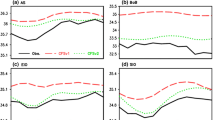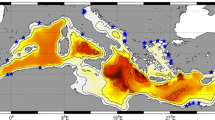Abstract
Warm bias of modeled sea surface temperature (SST) in the eastern boundary upwelling systems (EBUS) is a ubiquitous feature in coupled climate models. This paper investigates the causes underlying this warm bias, with a focus on the effect of horizontal resolution in the atmospheric component of coupled models, by using Community Earth System Model (CESM) as an example. By breaking down the energy budget of the upper ocean, we conclude that surface net heat flux and Ekman upwelling process exert a considerable influence (over 80%) on upper ocean temperature of EBUS in CESM. Besides, the problem of underestimation of stratocumulus cloud is not present near the coast, and hence not responsible for this warm bias in CESM. On the contrary, downward shortwave radiation bias is overcompensated by longwave radiation and latent flux bias on the open ocean. Therefore, the insufficient ocean dynamic upwelling is the dominantly cause for SST warm bias. Finer horizontal resolution atmosphere component of CESM enables better representation of low-level coastal jet structure, with stronger and closer alongshore wind stress and curl leading to realistic representation of upwelling process and horizontal water mass transportation. Furthermore, low-level coastal jet is shown to be sensitive to coastal mountain topography, especially in South East Pacific region, through both thermodynamic and dynamic atmospheric processes and oceanic response. This article provides further proof of improving coupled climate models in reducing the SST biases in EBUS regions.














Similar content being viewed by others
References
Breugem WP, Chang P, Jang CJ, Mignot J, Hazeleger W (2010) Barrier layers and tropical Atlantic SST biases in coupled GCMs. Tellus Series A-dynamic Meteorology And Oceanography 60(5):885–897
Colas F, Mcwilliams JC, Capet X, Kurian J (2012) Heat balance and eddies in the Peru-Chile current system. Clim Dyn 39(1-2):509–529
Danabasoglu G, Bates SC, Briegleb BP, Jayne SR, Jochum M, Large WG, Peacock S, Yeager SG (2012) The CCSM4 ocean component. J Clim 25(5):1361–1389
Gent PR, Yeager SG, Neale RB, Levis S, Bailey DA (2010) Improvements in a half degree atmosphere/land version of the CCSM. Clim Dyn 34(6):819–833
Holt TR (1996) Mesoscale forcing of a boundary layer jet along the California coast. J Geophys Res-Atmos 101(D2):4235–4254
Hu ZZ, Huang B, Pegion K (2008) Low cloud errors over the southeastern Atlantic in the NCEP CFS and their association with lower-tropospheric stability and air-sea interaction. J Geophys Res-Atmos 113(D12)
Huang B, Hu ZZ, Jha B (2007) Evolution of model systematic errors in the tropical Atlantic basin from coupled climate hindcasts. Clim Dyn 28(7-8):661–682
Hunke EC, Lipscomb WH (2008) CICE: the Los Alamos sea ice model documentation and software user’s manual version 4.0 la-cc-06-012. In: Version 4.0, LA-CC-06-012, Los Alamos National Laboratory
Hurrell JW, Holland MM, Gent PR, Ghan S, Kay JE, Kushner PJ, Lamarque JF, Large WG, Lawrence D, Lindsay K (2013) The community earth system model: a framework for collaborative research. Bull Am Meteorol Soc 94(9):1339–1360
Hurrell JW, Hack JJ, Shea D, et al. (2008) A new sea surface temperature and sea ice boundary dataset for the community atmosphere model. J Clim 21(19):5145–5153
Jung G, Prange M, Schulz M (2014) Uplift of Africa as a potential cause for Neogene intensification of the Benguela upwelling system. Nat Geosci 7(10):741–747
Large WG, Danabasoglu G (2006) Attribution and impacts of upper-ocean biases in CCSM3. J Clim 19 (11):2325–2346
Large WG, Yeager SG (2009) The global climatology of an interannually varying air-sea flux data set. Clim Dyn 33(2-3):341–364
Ma CC, Mechoso CR, Robertson AW, Arakawa A (1996) Peruvian stratus clouds and the tropical Pacific circulation: a coupled ocean-atmosphere GCM study. J Clim 9(7):1635–1645
Menkes CER, Vialard JG, Kennan SC, Boulanger JP, Madec GV (2006) A modeling study of the impact of tropical instability waves on the heat budget of the eastern equatorial Pacific. J Phys Oceanogr 36 (36):847–865
Mohrholz V, Schmidt M, Lutjeharms JRE (2001) The hydrography and dynamics of the Angola-Benguela frontal zone and environment in April 1999. S Afr J Sci 97(5):199–208
Neale RB, Richter J, Park S, Lauritzen PH, Vavrus SJ, Rasch PJ, Zhang M (2013) The mean climate of the community atmosphere model (CAM4) in forced SST and fully coupled experiments. J Clim 26 (14):5150–5168
Oleson KW, Niu GY, Yang ZA, Lawrence DM, Thornton PE, Lawrence PJ, Stackli R, Dickinson RE, Bonan GB, Levis S (2015) Improvements to the community land model and their impact on the hydrological cycle. J Geophys Res Biogeosci 113(G1):G01,021
Patricola CM, Chang P (2017) Structure and dynamics of the Benguela low-level coastal jet. Clim Dyn 49 (7-8):1–24
Patricola CM, Li M, Xu Z, Chang P, Saravanan R, Hsieh JS (2012) An investigation of tropical Atlantic bias in a high-resolution coupled regional climate model. Clim Dyn 39(9-10):2443–2463
Philander SGH, Yoon JH (1982) Eastern boundary currents and coastal upwelling. J Phys Oceanogr 12 (12):862–879
Pickett MH, Paduan JD (2003) Ekman transport and pumping in the California current based on the U.S. navy’s high-resolution atmospheric model (COAMPS) J Geophys Res Oceans. 108(C10)
Richter I (2015) Climate model biases in the eastern tropical oceans: causes, impacts and ways forward. Wiley Interdiscip Rev Clim Change 6(3):345–358
Richter I, Xie SP, Wittenberg AT, Masumoto Y (2011) Tropical Atlantic biases and their relation to surface wind stress and terrestrial precipitation. Clim Dyn 38(5):985–1001
Saha S, Moorthi S, Wu X, Wang J, Nadiga S, Tripp P, Behringer D, Hou YT, Chuang HY, Iredell M (2012) The NCEP climate forecast system version 2. J Clim 27(6):2185–2208
Shannon LV, Agenbag JJ, Buys MEL (1987) Large- and mesoscale features of the Angola-Benguela front. S Afr J Mar Sci 5(1):11–34
Small RJ, Curchitser E, Hedstrom K, Kauffman B, Large WG (2015) The Benguela upwelling system: quantifying the sensitivity to resolution and coastal wind representation in a global climate model. J Clim 28(23):150921125611,001
Stephens GL, Vane DG, Boain RJ, Mace GG, Sassen K, Wang Z, Illingworth AJ, O’connor EJ, Rossow WB, Durden SL, Miller SD (2002) The CloudSat mission and the A-Train: a new dimension of space-based observations of clouds and precipitation. Bull Am Meteorol Soc 83(12):1771–1790
Taylor KE, Stouffer RJ, Meehl GA (2012) An overview of CMIP5 and the experiment design. Bull Am Meteorol Soc 93(4):485–498
Wahl S, Latif M, Park W, Keenlyside N (2011) On the tropical Atlantic SST warm bias in the Kiel climate model. Clim Dyn 36(5-6):891–906
Wang C, Zhang L, Lee SK, Wu L, Mechoso CR (2014) A global perspective on CMIP5 climate model biases. Nat Clim Chang (3):201–205
Xu Z, Chang P, Richter I, Kim W, Tang G (2014) Diagnosing southeast tropical Atlantic SST and ocean circulation biases in the CMIP5 ensemble. Clim Dyn 43(11):3123–3145
Xu Z, Li M, Patricola CM, Chang P (2014) Oceanic origin of southeast tropical Atlantic biases. Clim Dyn 43(11):2915–2930
Yu L, Haines K, Bourassa M, Cronin M, Gulev S, Josey S, Kato S, Kumar A, Lee T, Roemmich D (2012) Towards achieving global closure of ocean heat and freshwater budgets: recommendations for advancing research in air-sea fluxes through collaborative activities
Zheng Y, Shinoda T, Kiladis GN, Lin J, Metzger EJ, Hurlburt HE, Giese BS (2012) Upper ocean processes under the stratus cloud deck in the southeast Pacific Ocean. J Phys Oceanogr 40(1):103–120
Acknowledgements
The authors thank the editor and referees for their invaluable efforts in improving the manuscript.
Funding
This work is partially supported by the National Key R & D Program of China under the grant number 2017YFA0603902 and the General Program of National Science Foundation of China under the grant number 41575076. This work is also partially supported by Center for High-Performance Computing and System Simulation, Pilot National Laboratory for Marine Science and Technology (Qingdao).
Author information
Authors and Affiliations
Corresponding author
Additional information
Responsible Editor: Tal Ezer
This article is part of the Topical Collection on the 10th International Workshop on Modeling the Ocean (IWMO), Santos, Brazil, 25–28 June 2018
Rights and permissions
About this article
Cite this article
Ma, J., Xu, S. & Wang, B. Warm bias of sea surface temperature in Eastern boundary current regions—a study of effects of horizontal resolution in CESM. Ocean Dynamics 69, 939–954 (2019). https://doi.org/10.1007/s10236-019-01280-4
Received:
Accepted:
Published:
Issue Date:
DOI: https://doi.org/10.1007/s10236-019-01280-4




